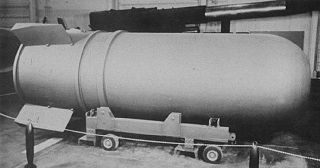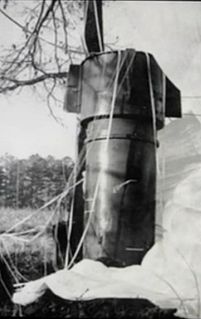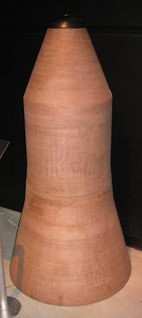Related Research Articles

A warhead is the explosive or toxic material that is delivered by a missile, rocket, or torpedo. It is a type of bomb.

Nuclear weapon designs are physical, chemical, and engineering arrangements that cause the physics package of a nuclear weapon to detonate. There are three existing basic design types:

Chevaline was a system to improve the penetrability of the warheads used by the British Polaris nuclear weapons system. Devised as an answer to the improved Soviet anti-ballistic missile defences around Moscow, the system increased the probability that at least one warhead would penetrate Moscow's anti-ballistic missile (ABM) defences, something which the Royal Navy's earlier UGM-27 Polaris re-entry vehicles (RV)s were thought to be unlikely to do.

The WE.177, originally styled as WE 177, and sometimes simply as WE177, was a series of tactical and strategic nuclear weapons equipping the Royal Navy (RN) and the Royal Air Force (RAF). It was the primary air-dropped nuclear weapon in the United Kingdom from the late 1960s into the 1990s.
Red Snow was a British thermonuclear weapon. Its physics package was shared with the United States and was used in the development of the United States W28 nuclear warhead used in the B28 nuclear bomb and AGM-28 Hound Dog missile, with an explosive yield of approximately 1.8 megaton.
Variable yield—or dial-a-yield—is an option available on most modern nuclear weapons. It allows the operator to specify a weapon's yield, or explosive power, allowing a single design to be used in different situations. For example, the Mod-10 B61 bomb had selectable explosive yields of 0.3, 5, 10 or 80 kilotons, depending on how the ground crew set a dial inside the casing when it was loaded onto an aircraft.

The B-41 was a thermonuclear weapon deployed by the United States Strategic Air Command in the early 1960s. It was the most powerful nuclear bomb ever developed by the United States, with a maximum yield of 25 megatons. The B-41 was the only three-stage thermonuclear weapon fielded by the U.S.
A boosted fission weapon usually refers to a type of nuclear bomb that uses a small amount of fusion fuel to increase the rate, and thus yield, of a fission reaction. The neutrons released by the fusion reactions add to the neutrons released due to fission, allowing for more neutron-induced fission reactions to take place. The rate of fission is thereby greatly increased such that much more of the fissile material is able to undergo fission before the core explosively disassembles. The fusion process itself adds only a small amount of energy to the process, perhaps 1%.

The W80 is a low to intermediate yield two-stage thermonuclear warhead deployed by the U.S. enduring stockpile with a variable yield ("dial-a-yield") of 5–150 kt of TNT.

A thermonuclear weapon, fusion weapon or hydrogen bomb, is a second-generation nuclear weapon design. Its greater sophistication affords it vastly greater destructive power than first-generation atomic bombs, a more compact size, a lower mass or a combination of these benefits. Characteristics of nuclear fusion reactions make possible the use of non-fissile depleted uranium as the weapon's main fuel, thus allowing more efficient use of scarce fissile material such as uranium-235 (U-235) or plutonium-239 (Pu-239).
The W52 was a thermonuclear warhead developed for the MGM-29 Sergeant short-range ballistic missile used by the United States Army from 1962 to 1977. The W52 is 24 inches in diameter and 57 inches long, and weighed 950 pounds. It had a yield of 200 kilotons. A total of 300 W52 warheads were produced.
According to researcher Chuck Hansen, the W34 Python was a gas-boosted fission primary used in several designs of American thermonuclear weapons.
The W58 was an American thermonuclear warhead used on the Polaris A-3 submarine-launched ballistic missile. Three W58 warheads were fitted as multiple warheads on each Polaris A-3 missile.

The Mark 39 nuclear bomb and W39 nuclear warhead were versions of an American thermonuclear weapon, which were in service from 1957 to 1966.

The W59 was an American thermonuclear warhead used on some Minuteman I ICBM missiles from 1962-1969, and planned to be used on the cancelled GAM-87 Skybolt air-launched ballistic missile.
Kinglet was a boosted fission primary used in two designs of American thermonuclear weapons, the W55 and the W58; and was also adapted by the British as a super-hardened primary known as Harriet used in the Chevaline improvements to the British Polaris A-3TK missile.

The Mark 15 nuclear bomb, or Mk-15, was a 1950s American thermonuclear bomb, the first relatively lightweight thermonuclear bomb created by the United States.

Orange Herald was a British nuclear weapon, tested on 31 May 1957. At the time it was reported as a H-bomb, although in fact it was a large boosted fission weapon.
A penetration aid is a device or tactic used to increase an intercontinental ballistic missile (ICBM) warhead's chances of penetrating a target's defenses.

Following the success of Operation Grapple in which the UK joined the club of thermonuclear nations, Britain launched negotiations with the US on a treaty under in which both could share information and material to design, test and maintain their nuclear weapons. This effort culminated in the 1958 US–UK Mutual Defence Agreement. One of the results of that treaty was that Britain was allowed to use United States' Nevada Test Site for testing their designs and ideas, and received full support from the personnel there, in exchange for the data "take" from the experiment, a mutual condition. In effect the Nevada Test Site became Britain's test ground, subject only to advance planning and integrating their testing into that of the United States. This resulted in 24 underground tests at the Nevada Test Site from 1958 through the end of nuclear testing in the US in September 1992.
References
- ↑ The Real Meaning of the Words: A Very Pedantic Guide to British Nuclear Weapons Codenames Archived March 14, 2012, at the Wayback Machine
- 1 2 Public Record Office, London. AVIA 65/1845
- ↑ Royal Aeronautical Society Symposium. The History of the UK Strategic Deterrent: The Chevaline Programme. 28 October 2004.
- ↑ http://nuclear-weapons.info/images/rebproportions.png
- ↑ Public Record Office, London. AVIA 65/1845 and 1846
- ↑ Public Record Office, London. DEFE 19/208 e47/2
